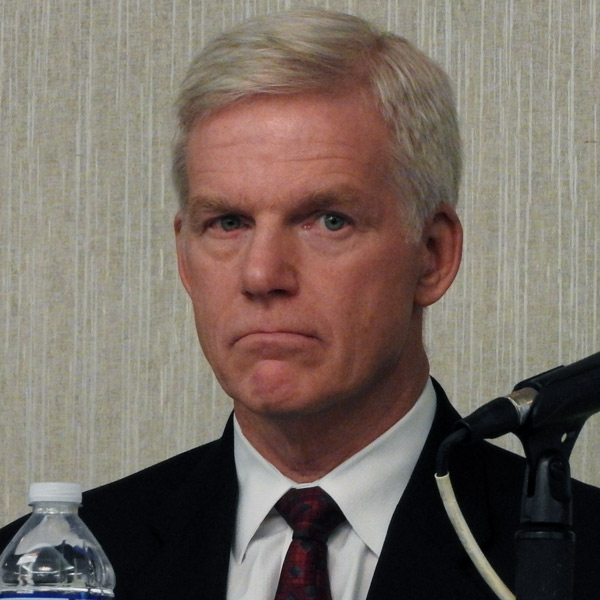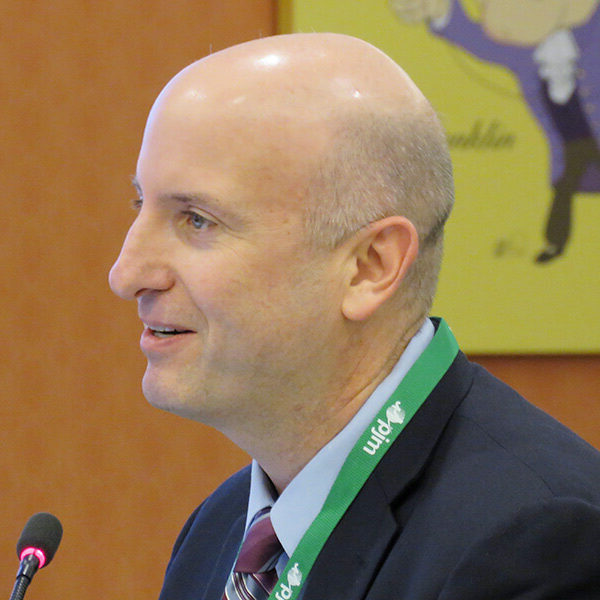The expedited phaseout of federal tax incentives for renewables threatens projects and jobs across the clean energy industry in New England and is likely to trigger a mad dash of developers and states pushing projects forward to meet the deadlines set by the One Big Beautiful Bill Act (OBBBA).
The law, which was signed by President Donald Trump on July 4, made a particular target of wind and solar resources and drew heavy criticism from climate and labor groups across the country. (See U.S. Clean Energy Sector Faces Cuts and Limitations.) It and its associated executive actions already appear to have triggered job losses in New England and threaten to cause the stagnation or contraction of the region’s growing clean energy industry and workforce.
“We are going to see, in all likelihood, projects stranded,” said Harry Godfrey, managing director at Advanced Energy United. “It’s bad for workers; it’s bad for consumers; it’s bad for American competitiveness.”
For clean energy developers, the OBBBA contains two key aspects. First, it significantly accelerates the phaseout of the investment and production tax credits (ITC and PTC) for wind and solar projects. To be eligible for the credits under the new rules, projects must begin construction by July 5, 2026, or, if they miss the construction deadline, must be placed in service by the end of 2027.
The law also requires strict foreign entity of concern (FEOC) restrictions, intended to prevent credits from going to companies owned or controlled by entities tied to China, North Korea, Iran or Russia, or to companies that source a certain portion of their equipment from these countries.
The projects likely to be most vulnerable to the phaseout, Godfrey said, are large-scale wind and solar projects that are two to three years away from beginning construction and could not feasibly expedite development to receive the tax credits.
For these projects, “the assumptions around the credits are baked into the project financing … and all of a sudden you have to go back and revise that,” Godfrey said.
Godfrey said the placed-in-service deadlines established in the law will create major investment risks for projects aiming to meet the deadlines because factors largely outside the control of the developer — such as permitting, interconnection or legal challenges — all could cause a project to miss a deadline.
“A placed-in-service deadline really becomes an effective project killer,” he said.
Offshore Wind
In Massachusetts, the biggest effects of the Trump administration may be on the offshore wind industry.
Lawmakers and clean energy advocates in the state have long envisioned offshore wind as an essential resource for meeting growing power demand and decarbonizing the economy. ISO-NE has emphasized the importance of offshore wind to maintaining reliability and resource adequacy.
However, while Revolution Wind and Vineyard Wind are fully contracted, under construction and set to come online over the next two years barring unforeseen obstacles, the region’s second wave of projects faces a highly uncertain future.
New England Wind 1 and SouthCoast Wind, which both received their final federal permitting approvals under the Biden administration and were selected in a 2024 multistate solicitation, have seen repeated delays to their contract negotiations because of federal policy uncertainty. (See New England OSW Contracts Delayed Again.)
“The OBBBA essentially shoots a 30% hole through the financing of solar and wind projects, and that’s not possible to make up from state incentives,” said Amy Boyd Rabin, vice president of policy at the Environmental League of Massachusetts. “It is a significant blow to renewable energy and significantly undoes a lot of the work that prior administrations had done to level the playing field with all the subsidies and incentives we give fossil fuels.”
Offshore wind developers have indicated they are closely awaiting guidance from the Treasury Department on the start-of-construction rules and will need a significant degree of federal policy certainty to proceed with the second wave of projects in the region.
Elizabeth Mahony, commissioner of the Massachusetts Department of Energy Resources, said the “biggest challenge we’re seeing at the federal landscape is the Day 1 executive orders on permitting,” adding that “not having a clear picture on permitting is a significant challenge.”
The Trump administration has not shied away from targeting fully permitted projects, as Trump’s Day 1 order directed a review of existing wind energy leases. In April the administration halted construction on the fully permitted Empire Wind 1 project, which is under contract with New York. The administration ultimately lifted the halt in May, reportedly in exchange for concessions from New York regarding new gas infrastructure into the state. (See BOEM Lifts Stop-work Order on Empire Wind.)
Asked whether Massachusetts would consider a similar hypothetical deal to lift federal permitting barriers to offshore wind in exchange for state concessions around natural gas infrastructure, Mahony said the state is “focused on what we can control, and that’s solar, storage and wind programs that we have actively going in Massachusetts.”
“The governor has repeatedly said that we are an all-of-the-above-solution state,” Mahony added.
Offshore wind project cancellations or major delays will have a major impact on the state’s clean energy workforce. The construction of Vineyard Wind has created about 1,000 union jobs, and the Massachusetts Clean Energy Center forecasted in 2023 that offshore wind would be the fastest growing subsector of the clean energy workforce by 2030.
“We see offshore wind as a really big opportunity,” said Ryan Murphy, executive director of Climate Jobs Massachusetts, a labor union coalition group. “It would be a significant loss if those projects don’t go forward during the Trump administration.”
The administration already appears to have caused job losses in the region. In February, in the wake of Trump’s executive order halting permitting approvals for offshore wind, the developer Vineyard Offshore cut 50 jobs.
“For the projects that we know are planned for Massachusetts that are either on hold or have been canceled, we estimate more than 5,000 construction jobs would not go forward if those projects don’t go forward,” Murphy said.
Along with immediate impacts on local communities, businesses and working families, “what that means is that unions — without commitments to jobs — are not able to train as many workers in the meantime to get them ready for future clean energy projects,” Murphy said.
He added that while most of the skills taught by unions are transferable to a range of other infrastructure and energy projects, “the fact is, if you take away thousands of construction jobs, you don’t necessarily have a one-to-one replacement or thousands of other construction jobs that those workers can go and do.”
Solar Development
The looming expiration of the PTC and ITC also poses a major threat to the solar industry in New England.
The ITC, which was expanded and extended by the Biden administration, has been the “foundation of clean energy development in this country for 20 years,” said Jessica Robertson, director of policy and business development in New England for New Leaf Energy.
Looking at New Leaf’s project pipeline under existing conditions, projects that would be able to survive without the ITC are “very few and far between,” said Robertson, who added she’s optimistic the company took the necessary steps to meet start-of-construction deadlines for its projects prior to the passage of the OBBBA. That should help protect its project pipeline in the near term.
But project eligibility for tax credits likely will depend on the stringency of the guidance issued by the Treasury, and whether the administration seeks to apply the changes retroactively to investments that were made to safe harbor projects prior to the law’s enactment.
In an executive order issued after signing the bill, Trump directed the treasury secretary to issue new guidance “to ensure that policies concerning the ‘beginning of construction’ are not circumvented, including by preventing the artificial acceleration or manipulation of eligibility and by restricting the use of broad safe harbors.” (See Trump Executive Order Targets Renewable Energy Tax Credits.)
At the state level, Robertson expressed hope that recent policy changes, particularly in Massachusetts, will help reduce development costs associated with interconnection and permitting, and may even help some projects meet the tax credit expiration deadlines set by the law.
The Massachusetts legislature passed major siting and permitting reform legislation in late 2024, limiting the permitting approval timeline to 12 months for small clean energy projects and 15 months for large projects, and allowing developers to appeal local permit rejections to the state Energy Facilities Siting Board. (See Mass. Clean Energy Permitting, Gas Reform Bill Back on Track.)
The state also has established a framework for covering the upfront costs of distribution-level interconnection upgrades in the rate base and has required more proactive planning in the utility Electric Sector Modernization Plans. (See Mass. DPU Approves 1st Round of Utility Grid Modernization Plans.)
Massachusetts also issued in June an emergency update to its Solar Massachusetts Renewable Target program, a key state policy for supporting solar development. The changes are intended to allow the program to reflect annual changes in the cost of building solar and help the state respond to changing federal policy.
But states can do only so much to fill the gaps left by the loss of federal tax credits. New Leaf announced in July the layoff of about a fifth of its workforce, citing the need to “reduce its cost structure in preparation for a market without the federal ITC.”
Robertson said the company’s utility-scale projects that cannot meet the in-service deadlines will be most affected by the tax credit changes and said New Leaf is “exploring our options for those projects.”
Storage Development
While the OBBBA made relatively minor changes to the ITC deadlines for energy storage, development likely will face significant impacts from the FEOC changes.
“There’s significant opportunity for folks to focus on storage, or pair their projects with storage, to retain some of the ITC for that portion of the project,” said Sean Burke, director of policy at BlueWave Energy. “However, the foreign entity of concern provisions in the One Big Beautiful Bill are complex and novel for the industry to deal with, and I think it’s going to take some time for us to all figure out how those work.”
Compared to wind and solar, Burke said storage developers are required to source a higher percentage of their components from non-FEOC suppliers, with this percentage set to increase over time.
These requirements will depend in part on how the Treasury implements the bill’s FEOC restrictions. Trump’s July 7 executive order directed the department to act on the FEOC restrictions within 45 days of the law’s enactment.
Ultimately, the ITC remains “vitally important” for storage development, Burke said, adding that the “biggest challenge at this point” for storage developers is uncertainty around FEOC guidance, and “whether that will make it more challenging for projects to meet those requirements than was envisioned in the legislation.”
Storage development has been a major focus in New England in recent years, and the Massachusetts legislature in 2024 directed the procurement of 5,000 MW of storage by mid-2030, which must include significant amounts of long-duration storage. (See Mass. Clean Energy Permitting, Gas Reform Bill Back on Track.)
Burke said states procuring storage “need to be aware of the changing landscape around foreign entity of concern” and must be diligent about supplier claims of compliance with FEOC guidelines “because the rules are so complex that claims may not bear out in reality, and that would impact the viability of the bid.”


